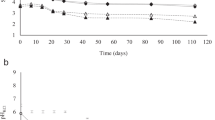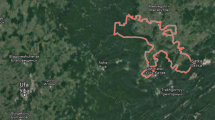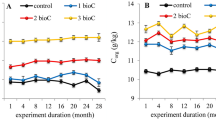Abstract
THE part played by humic manures in soil processes and in plant nutrition, both as a source of mineral elements and by improving the physical condition of the soil, is well known. The advantages of properly devised rotational systems of cropping in soil husbandry are also established by both practice and experience. It is therefore reasonable to expect results of great economic importance by a combination of rotational cropping with humic manuring. The permanent manurial small plots at the Institute of Plant Industry, Indore, afforded an opportunity of studying the relative importance of humic manures and crop rotation on the conservation of soil properties. These plots, sixteen in number, have, since 1933, been receiving annual surface dressings of farm compoat, farmyard manure and municipal compost, all at ten tons per acre, and have been under a four-year rotational cropping with (i) cotton, (ii) sann (Orotalaria juncea), ploughed in and followed by wheat, (iii) ground nut, and (iv) jowar (Andropogon sorghum) ; one set of four plots (including a control immanured plot) being under a particular crop during a season. The plots treated with the different humic manures, while yielding more or less alike from year to year with all the crops, had frequently given more than double the yields of the untreated plots.
This is a preview of subscription content, access via your institution
Access options
Subscribe to this journal
Receive 51 print issues and online access
$199.00 per year
only $3.90 per issue
Buy this article
- Purchase on Springer Link
- Instant access to full article PDF
Prices may be subject to local taxes which are calculated during checkout
Similar content being viewed by others
References
Tamhane, V. A., and Sreenivasan, A., Curr. Sci., 12, 135 (1943).
Russell, E. J., and Watson, D. J., Imp. Bureau of Soil Sci., Tech. Commn., 40, 50 (1940).
Russell, E. J., and Voelcker, J. A., "Fifty Years of Field Experiments at the Woburn Experimental Station" (London: Longmans, 1936), 322.
Dhar, N. R., and Mukerji, S. K., NATURE, 138, 1060 (1936).
Dhar, N. R., NATURE, 151, 590 (1943).
Russell, J. C., J. Amer. Soc. Agron., 19, 380 (1927).
Jenny, H., J. Amer. Soc. Agron., 20, 900 (1928); Soil Sci., 29, 193(1930).
Sahasrabuddhe, D. L., Proc. Nat. Inst. Sci., India, 3, 139 (1937).
Mohr, E. C. J., cited from S. A. Waksman's "Humus" (London: Baillière, Tindall and Cox, 1938), 2nd edit., 258.
Author information
Authors and Affiliations
Rights and permissions
About this article
Cite this article
SREENIVASAN, A. CONSERVATION OF HUMUS IN TROPICAL SOILS. Nature 152, 572–573 (1943). https://doi.org/10.1038/152572a0
Issue Date:
DOI: https://doi.org/10.1038/152572a0
This article is cited by
-
Nitrogenous Manuring of Black Cotton Soil
Nature (1944)
Comments
By submitting a comment you agree to abide by our Terms and Community Guidelines. If you find something abusive or that does not comply with our terms or guidelines please flag it as inappropriate.



